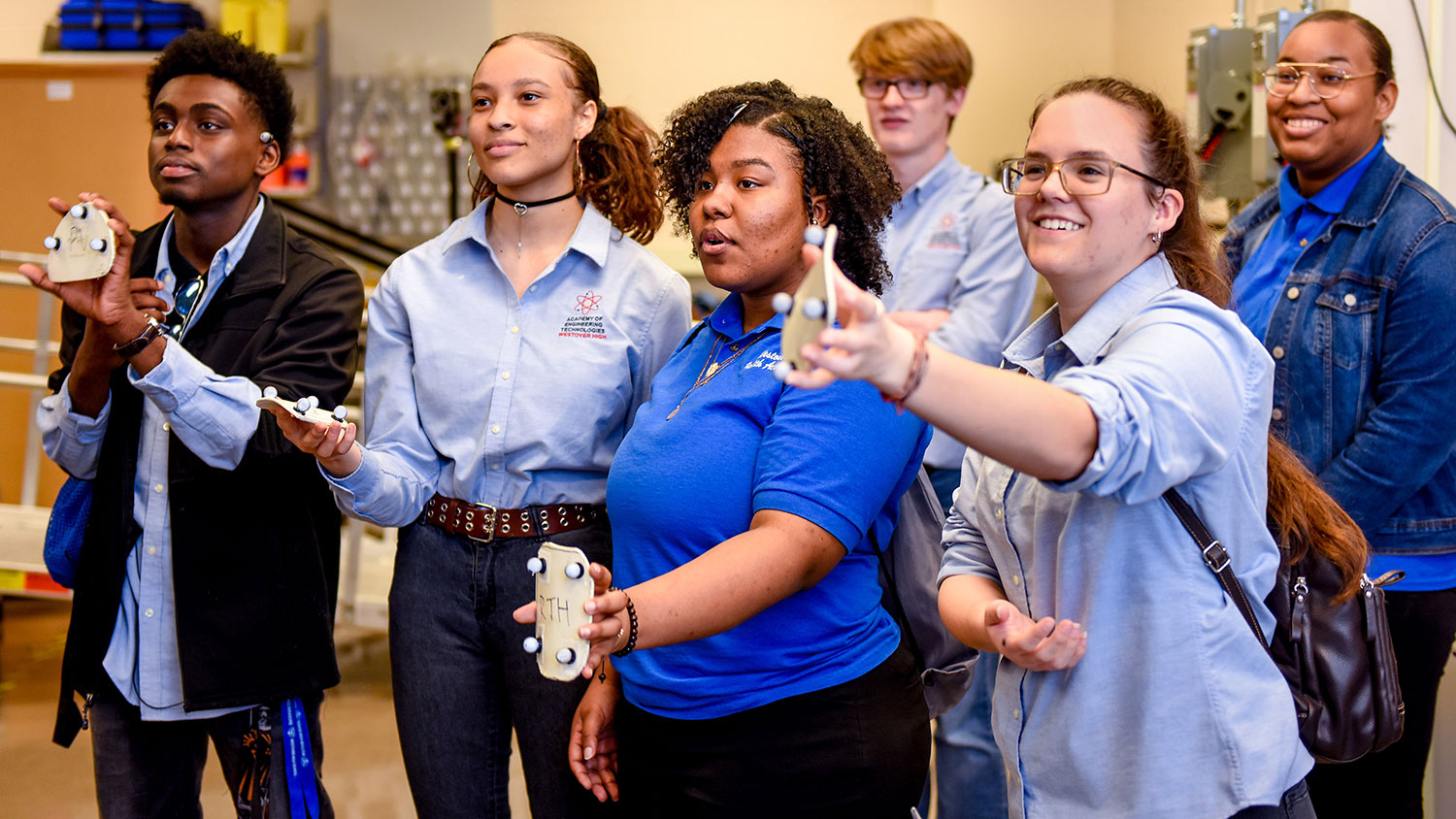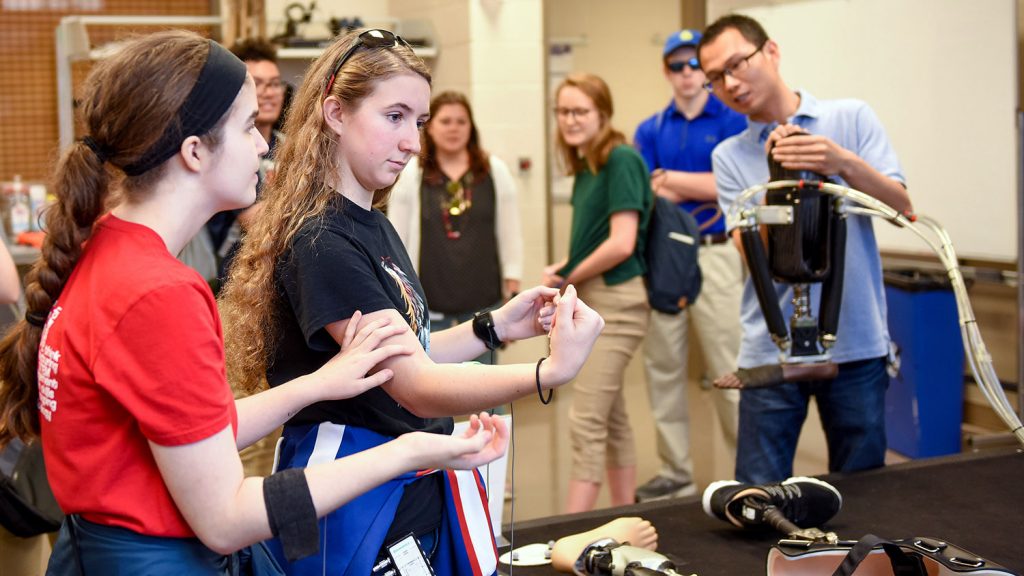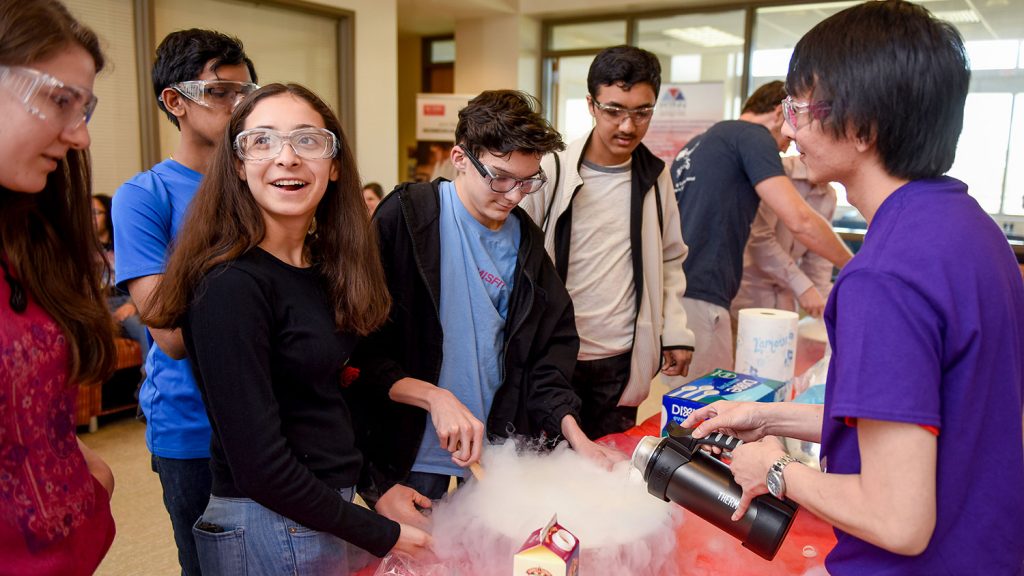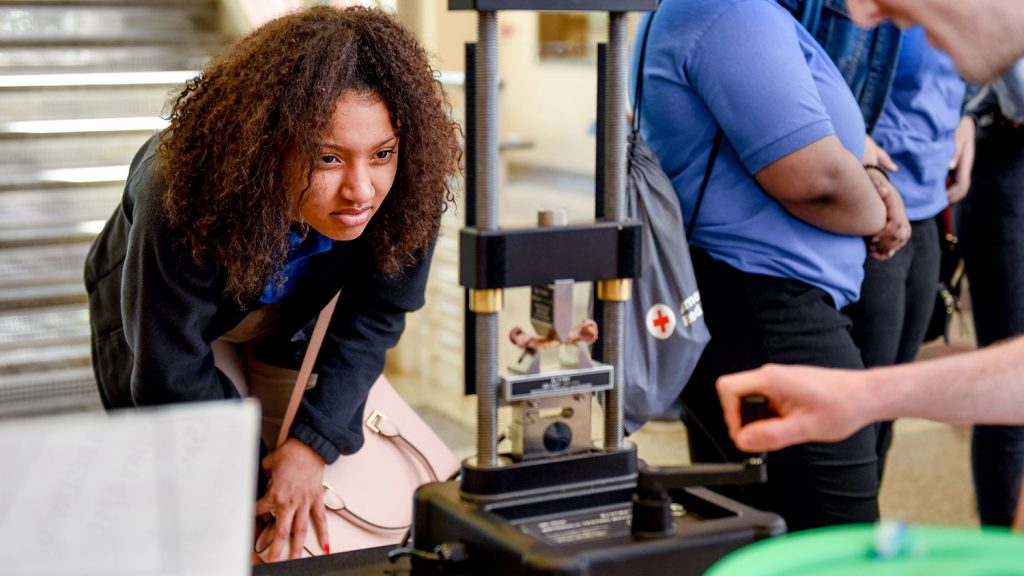Building Bridges to Biomechanics

Two high school students stand in the middle of an NC State engineering lab fidgeting with small sensors attached to their forearms. Taking a cue from one of the lab’s researchers, they start moving their wrists up and down — hesitantly at first, then with growing excitement — bringing to life a prosthetic foot located about 3 feet away.
Their classmates huddle around, craning their necks to get a good look.
“It’s like the Terminator,” one of them says, eliciting giggles.
Resemblance aside, the prosthetic is not, in fact, designed to turn you into a cyborg assassin. It responds to neural impulses the way human limbs do, giving wearers more power when they’re moving around.
The technology is being developed by researchers in Helen Huang’s Neuromuscular Rehabilitation Engineering Lab. And this group of high-schoolers got a sneak peek as participants in National Biomechanics Day at NC State.

Designed to open doors (and minds) to the field of biomechanics, the event is sponsored by the American Society of Biomechanics and takes place each year at colleges and universities worldwide.
NC State’s April event brought 140 high school students and their teachers to Centennial Campus for expo-style demonstrations, lab tours and the ever-popular liquid nitrogen ice cream.
“Biomechanics is a very broad, active area of research on human movement that ranges from the cellular and molecular level all the way up to designing orthotics and joint replacements,” says Jacque Cole, assistant professor in the UNC and NC State Joint Department of Biomedical Engineering. “But training doesn’t exist until you get to the senior undergraduate level or sometimes the graduate level, depending on the program and the university. So many high school students have never heard of it.
“We host this event to get young people excited about biomechanics, open their eyes to it as a career opportunity and perhaps help advance the field.”
‘We Solve Problems’
In the airy lobbies of all four floors of Engineering Building III, student and faculty volunteers gave demonstrations on everything from bone fracture healing to 3-D bioprinting (using computer-aided models to replicate human tissues and organs).
At the “Nano Ice Cream” booth, Toby Tung, an IT and instrumentation manager in the Department of Materials Science and Engineering, discussed the phases, temperature, chemistry and materials required to create ice cream using liquid nitrogen.

“My name is Toby, and I’m an engineer,” he says. “What do engineers do? We solve problems. The problem is you’re hungry. So we’re going to make ice cream.”
The students ate it up. Literally.
They came from as far as Fayetteville for the annual half-day event, some visiting NC State’s campus for the first time.
“Ideally, we would love to target students who don’t get as much exposure to science and engineering, so we reached out to more underserved communities this year in hopes to expand our participant base beyond a 10-mile radius of NC State,” says Stephanie Teeter, biomedical engineering research technician.
Cultivating New Understanding
The university began hosting National Biomechanics Day a few years ago, drawing about 50 local high school students to campus. It continues to grow, especially after the format changed from one focused only on lab tours to a broader, more hands-on experience.
And Cole and Teeter want to keep growing it.
The goal, they say, is for it to become a larger engineering expo, encompassing more than just biomechanics.
They’re off to a good start, with volunteers at this year’s event from several different areas: biomedical engineering, mechanical and aerospace engineering, industrial and systems engineering, and materials science and engineering. Volunteers also came from the Research Triangle Nanotechnology Network and The Engineering Place.

Teeter is pursuing a Ph.D. in STEM education and through her coursework has gained fresh understanding of how to engage students at the high school level.
“Rather than trying to teach these students, we’re focusing on what makes them excited,” she says. “There’s no pressure to learn anything at this event. We just want them to leave here with a new understanding of how cool biomechanics is. And then, hopefully, they’ll want to explore it in college.”
Based on data from previous events, the approach seems to be working.
After attending National Biomechanics Day at NC State last year, the majority of students strongly agreed with statements about engineering — and biomechanics in particular — as an interesting field and one they could see themselves pursuing, Teeter says.
“Sometimes you can hear the students as they’re walking around talking to each other about how cool a particular demonstration is,” Cole says. “Then they’ll relate it to something they’re already familiar with, and that’s exactly what we want. They also say that they can see themselves doing biomechanics, that their self-perception has expanded. That’s what really excites us.”
- Categories:


